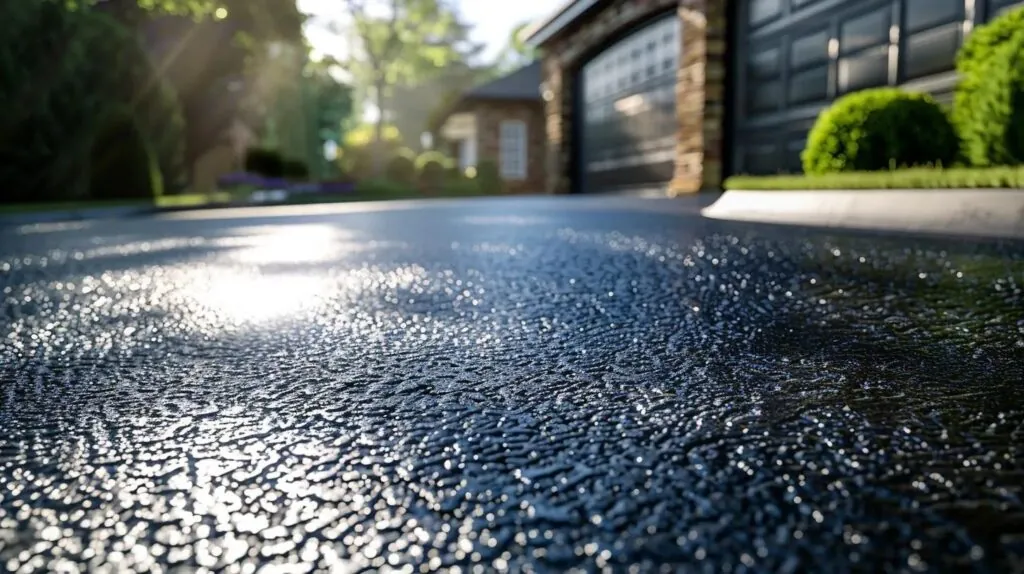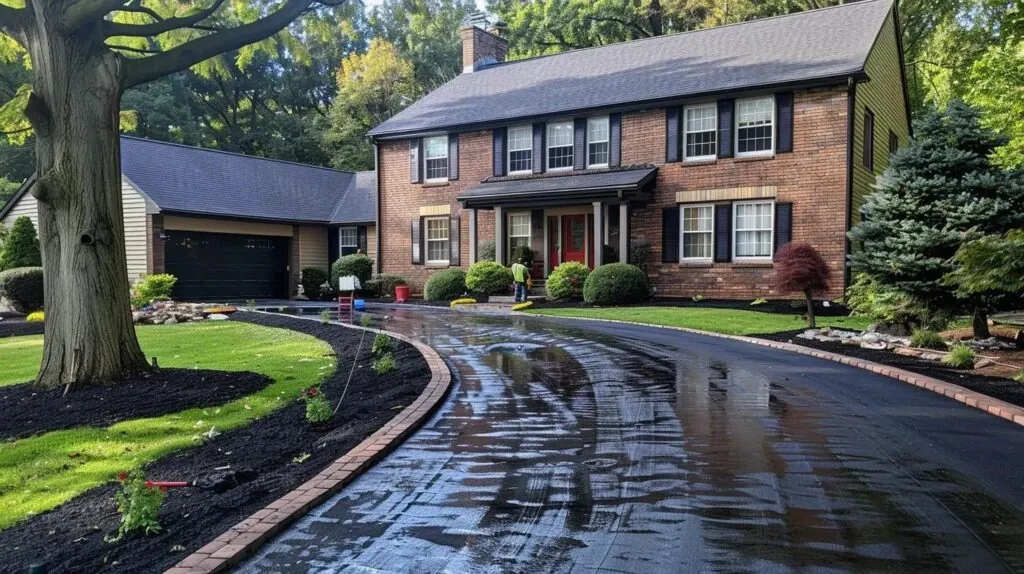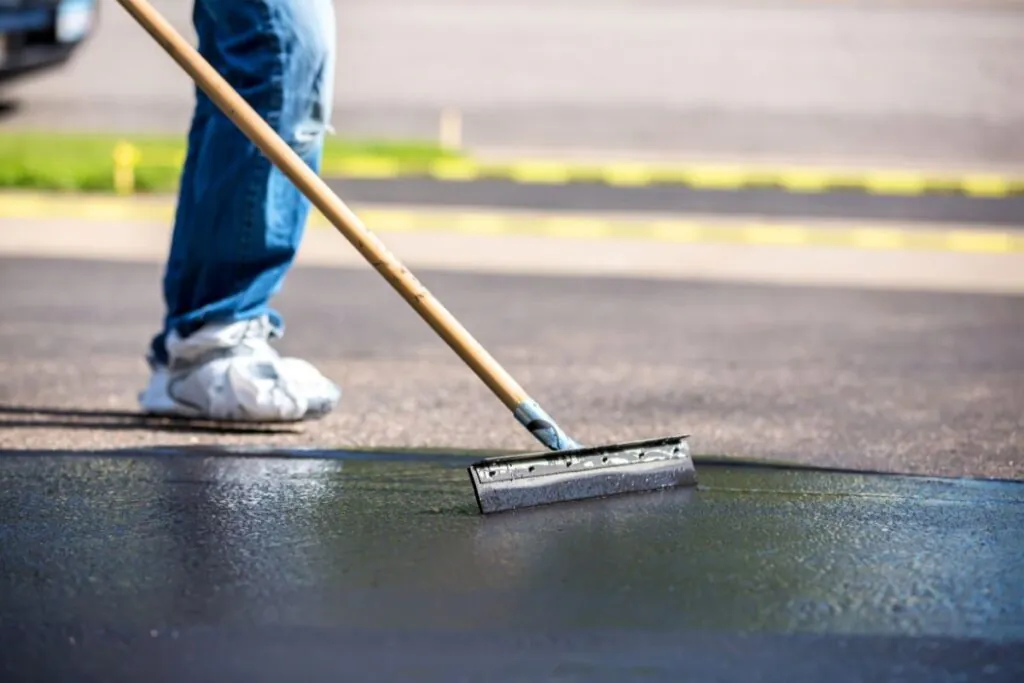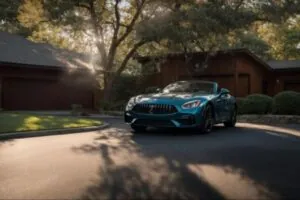Your driveway plays a key role in your home’s overall curb appeal and functionality, but wear and tear can lead to cracks, fading, and even structural damage over time. When faced with this, homeowners often struggle with a common dilemma: sealcoat vs repave.
Do you opt for the more budget-friendly solution of sealcoating, which adds a protective layer to your existing surface? Or is it time for a complete repaving to start fresh? Choosing the right option can feel overwhelming, but it is essential to make the decision that fits your budget and extends the life of your driveway. Knowing your options and making an informed choice is just one thing a homeowner has to consider when maintaining their driveway.
In this blog, we will explore the differences between sealcoating and repaving, highlighting the benefits, costs, and ideal scenarios for each. Whether your driveway has minor cracks or more significant damage, this guide will help you decide which route to take for a smooth, durable finish. By the end, you will feel confident in knowing what is best for your driveway’s condition and your long-term goals.
Key Takeaways
- Sealcoating adds a protective layer to an existing driveway surface, helping to prevent cracks, fading, and damage from weather.
- Repaving involves completely removing and replacing the driveway, offering a brand-new surface.
- Sealcoating is ideal for minor cracks and surface-level wear, while repaving is best for severe damage and structural issues.
- Sealcoating is often the better choice for cost savings, maintenance ease, and preventing future damage.
What Is Sealcoating?

Sealcoating is a protective layer applied to asphalt driveways to safeguard them from the elements, including UV rays, water, and chemicals like oil or gas. Over time, these factors can cause cracks, fading, and surface damage. Sealcoating forms a barrier that helps maintain the driveway’s appearance and extends its lifespan. Think of it like a protective skin over the driveway surface that takes the bulk of the wear and tear to extend the life of the driveway surface. Let’s dive into the details of sealcoating and what it does for your paved surfaces: why you should sealcoat your driveway.
The Basics of Sealcoating
Sealcoating involves applying a liquid sealant over your driveway’s surface, creating a protective shield. This process usually requires a clean, dry surface and is best done during warmer months. The sealant is either sprayed or spread evenly across the asphalt. Once dried, the layer helps protect against cracking and wear, preserving the driveway for years.
Key Benefits of Sealcoating
Sealcoating offers several key benefits, including cost-effectiveness and protection from damage. It prevents water from seeping into small cracks, reducing the risk of more extensive, costly repairs later. Sealcoating also shields against UV damage, which can lead to fading and weakening. Additionally, it improves curb appeal by giving the driveway a fresh, smooth finish.
What Is Repaving?
Repaving is the process of completely removing and replacing the old asphalt on your driveway. This is often necessary when the surface has significant damage, such as large cracks, potholes, or structural issues. Repaving provides a brand-new surface that restores your driveway’s functionality and appearance. Here are the key basics you need to know about repaving to determine if it is the right option for your home’s driveway:
The Basics of Repaving
Repaving begins by removing the existing asphalt layer through grinding or excavation. Once the old surface is cleared, a new asphalt layer is applied, compacted, and smoothed out. This process typically requires heavy machinery and skilled labor. Repaving offers a completely renewed surface that eliminates deep cracks and damage.
Key Benefits of Repaving
Repaving provides several critical benefits, including improved durability and longer lifespan. It completely addresses underlying issues like large cracks and potholes, making your driveway safer and more reliable. Additionally, repaving enhances your property’s overall curb appeal and value, offering a fresh, brand-new look that lasts for many years.
Sealcoating vs. Repaving: Key Differences

When deciding between sealcoating and repaving, it is essential to consider several key factors. Each option offers distinct advantages depending on your driveway’s condition, budget, and your long-term goals. Below, we will explore the main differences in cost, maintenance, longevity, and the time/disruption involved in each process. Let’s dive in now and get started!
1. Cost
Sealcoating is generally the more affordable option, making it ideal for homeowners looking for a quick, cost-effective way to extend their driveway’s lifespan. Repaving, however, requires a larger upfront investment due to the labor, materials, and time needed to remove and replace the asphalt completely.
2. Maintenance
Sealcoating requires periodic maintenance, typically every 2-3 years, to keep the protective layer intact and prevent damage. Repaving offers a longer-lasting solution with less frequent maintenance, though, over time, even repaved driveways may require minor repairs to address cracks or wear from weather exposure.
3. Longevity
Repaving provides a more durable and long-lasting result compared to sealcoating. While sealcoating extends the life of your existing surface by a few years, repaving can last up to 20 years or more. However, regular sealcoating applications can still help maintain a driveway’s surface over time.
4. Time and Disruption
Sealcoating is a quick process, often completed in just a few hours, with minimal disruption. You can usually start using your driveway again within 24-48 hours. Repaving, however, is more time-intensive, taking several days to complete and requiring additional time for the new surface to fully cure before it’s ready for use.
When Should You Sealcoat vs. Repave?
Deciding whether to sealcoat or repave depends on your driveway’s condition and the damage’s extent. Sealcoating is best for preventative care and minor repairs, while repaving is necessary for more severe issues. Understanding when to use each method can save you time and money in the long run. Here are the basics to keep in mind as you consider the options:
Ideal Conditions for Sealcoating
Sealcoating is ideal when your driveway has minor surface-level wear, such as small cracks or fading caused by sun exposure. It works best as a preventative measure, adding a protective layer to preserve the asphalt. If your driveway is relatively new or in good condition, sealcoating is the perfect solution to maintain it.
When Repaving Is Necessary
Repaving is necessary when significant damage, like large cracks, potholes, or structural issues, goes beyond surface-level problems. If your driveway has considerable wear and tear or has aged considerably, repaving will provide a fresh start and ensure long-term durability, eliminating the need for constant repairs.
Why Sealcoating Is Often the Better Option
Homeowners frequently favor sealcoating due to its affordability, effectiveness, and ease of maintenance. While it may not address deep structural issues, it provides significant benefits for preserving the condition of your driveway. Understanding why sealcoating is often the better choice can help you make an informed decision.
Affordable and Effective
One of the most compelling reasons to choose sealcoating is its affordability. Sealcoating requires a lower investment than repaving, making it accessible for many homeowners. This cost-effective solution effectively enhances the appearance of your driveway while providing a protective layer that shields against wear, ensuring that your investment lasts longer.
Prevents Future Damage
Sealcoating serves as a barrier against potential damage caused by environmental factors, such as rain, snow, and UV rays. Sealing small cracks and preventing water infiltration helps minimize the risk of more significant issues down the road. This proactive approach saves homeowners from costly repairs and extends the life of their driveway.
Low Maintenance
Another advantage of sealcoating is its low maintenance requirement. Once applied, a sealcoated driveway typically needs reapplication every 2-3 years, allowing homeowners to enjoy their driveways without constant worry. Regular maintenance is minimal, making it a practical choice for those who want to keep their driveways looking great with minimal effort.
Choose Sealcoating for Long-Term Savings and Protection
Sealcoating offers an affordable, effective, and low-maintenance solution for homeowners looking to protect and preserve their driveways. Providing a protective barrier against the elements enhances the driveway’s appearance and extends its lifespan, saving you money on costly repairs.

When weighing your options, consider the significant long-term savings and benefits of sealcoating. Choosing sealcoating is a smart investment in your home’s curb appeal and durability, ensuring your driveway remains in excellent condition for years to come. Do not put it off any longer- make the call today and protect your driveway with Donovan Sealcoating!
Frequently Ask Questions
Should I seal or resurface my driveway?
Seal if there’s minor wear; resurface if there are significant cracks or damage. Sealing is for maintenance, while resurfacing is for more serious issues. If your driveway is in good condition, sealing is enough, but resurfacing is better for aging driveways.
What is the difference between repaving and resurfacing?
Resurfacing adds a new asphalt layer, while repaving involves removing and replacing the entire driveway. Resurfacing is quicker and cheaper but only fixes surface issues, whereas repaving addresses deeper structural problems.
What does repaving a driveway mean?
Repaving means removing the old asphalt and laying down a new driveway. It’s used when the driveway is too damaged for resurfacing to be effective.
What is the downside of sealcoating a driveway?
Sealcoating doesn’t repair structural damage and needs reapplication every few years. It may not be cost-effective for heavily damaged driveways.
Why is sealing your blacktop driveway pointless?
Sealing is ineffective for driveways with significant damage and may not be necessary with modern, durable asphalt. It’s a temporary fix if deeper issues exist.



